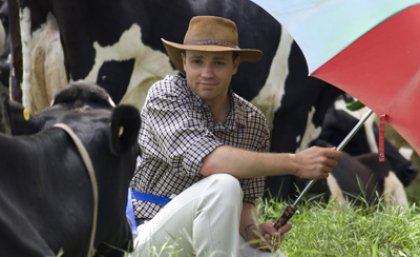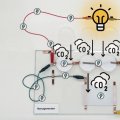
Terms like “giving the evil eye” and “right hand man” have been commonplace since the ancient Greeks realised that humans perceive their world very differently on the left and right sides of their body.
Now we know that the same can be said for cattle.
Dr Andrew Robins and Professor Clive Phillips from The University of Queensland’s Centre for Animal Welfare and Ethics (CAWE) have published their findings of an investigation to determine whether cattle possess “visual lateralisation”.
Lateralisation is the specialised process known to occur within either the left or right side of the vertebrate brain.
“There appears to be a common lateralised ancestor,” Dr Robins said.
“In all species studied, from fish to mammals, there is a consistent pattern of specialised functions carried out on either side of the brain. The right side specialises in the rapid analysis of, and response to, novel or threatening stimuli such as predators.
"By contrast, the left side of the brain specialises in considered, detailed processing such as deciding what to eat and what to avoid eating.”
Director of CAWE, Professor Clive Phillips is excited about the results.
“CAWE research has demonstrated that cattle are more likely to cross the paths of humans with the person in the left eye field of vision, that is, from the right-hand side of the person to the left than vice versa.
"Direct implications of the CAWE research will facilitate improved husbandry methods and cattle welfare using this new understanding of their herding behaviour.
"A related implication includes improved yard designs to incorporate cattle’s visual preferences.”
The study aimed to find out if cattle preferred to view a potential threat with either their left or right eye.
The CAWE team followed up on a Russian study that found intensively-housed dairy herd productivity varied, depending on the direction they received their food.
The Russian researchers found that dairy cattle that always fed from a tractor and hopper moving rightwards past their stall were 10 per cent more productive than cattle fed from the leftwards direction.
The Russians concluded that the productivity differences were related to other studies finding lateralisation in the right side of the brain’s control of the Sympathetic nervous system – which coordinates milk let-down as well as the “flight or fight” response.
This led Dr Robins and Professor Phillips to devise their “herd-splitting” experiments where the middle of herd groups of 17 to 33 head were divided by a researcher advancing on foot, with successively more threatening stimuli.
First the experimenter walked alone, then with an umbrella, next a wide forked apparatus, and finally an idling whipper-snipper engine.
The cattle consistently and significantly preferred to orient themselves to view the novel and potential threat with their left eye, which meant that the cattle were choosing to analyse the threat with the right side of their brain.
The paper entitled “Lateralised visual processing in domestic cattle herds responding to novel and familiar stimuli” was published in the journal "Laterality: Asymmetries of Body, Brain and Cognition" and resulted from the award of a small grant from the Australian Veterinarian Association’s Animal Welfare Trust.
Would you like to see more research to improve animal welfare?
Please contact the Centre for Animal Welfare and Ethics for more information on this research or to support further research to improve animal welfare. www.uq.edu.au/cawe
Media: Erin Pearl, 07 54 601 229 or Professor Clive Phillips 07 54 601 158


